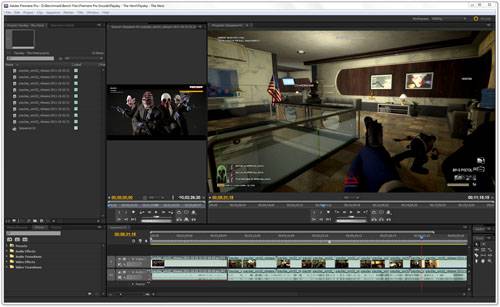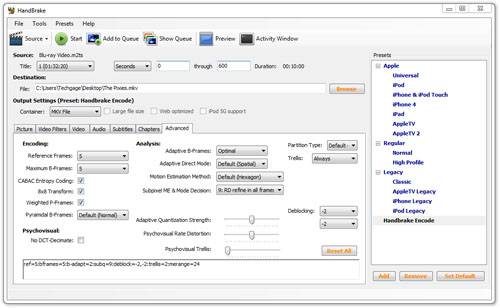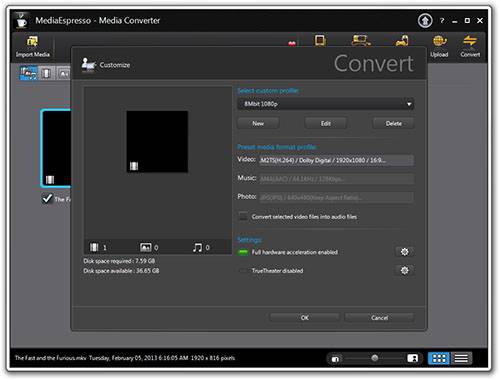- Qualcomm Launches Snapdragon 4 Gen 2 Mobile Platform
- AMD Launches Ryzen PRO 7000 Series Mobile & Desktop Platform
- Intel Launches Sleek Single-Slot Arc Pro A60 Workstation Graphics Card
- NVIDIA Announces Latest Ada Lovelace Additions: GeForce RTX 4060 Ti & RTX 4060
- Maxon Redshift With AMD Radeon GPU Rendering Support Now Available
Intel Core i7-4770K Quad-Core Processor Review

Intel’s latest processor architecture brings a lot to the table, with the usual suspects dominating the feature’s-list: improved CPU and GPU performance, better power-efficiency, and new instruction sets. We’re taking a look at the desktop line’s highest-end offering here, so let’s see how it stacks up against the last-gen’s champ.
Page 5 – Multi-Media: Adobe Premiere Pro, HandBrake & CyberLink MediaExpresso
With our 3D modeling and rendering tests out of the way, let’s dive right into another popular use for high-end machines: video editing and encoding. Scenarios here could include encoding a large movie into a mobile format, ripping a Blu-ray to your PC and encoding it for HTPC use, or encoding a family video you painstakingly edited.
Adobe’s Premiere Pro likely needs no introduction. It’s a tool used by the amateur and professional video content creator alike due to the extreme control it provides along with all of the important codecs, presets, filters and tweaking options. Premiere Pro can be used for any sort of video, be it real-life, animated, 3D or even game footage.
For our benchmarking, we encode a project that consists of 35GB worth of game footage from Payday: The Heist, which we encode to MPEG2 Blu-ray 1080p/30. The resulting video can be seen here.
To ensure an encode delivers the best possible video quality, we enable the “Maximum Quality Render”, which results in nearly 100% CPU utilization on up to 12 threads (we have not tested on CPUs that have more than 12 threads).

Core count matters a lot with a test like this, so the i7-3960X wins rather handily. It’s the i7-4770K vs. i7-3770K matchup that’s most interesting though, given one replaces the other. There, Intel’s latest proves to be quite the performer, shaving almost 11% off of the total time.
HandBrake 0.9.9
Premiere Pro is meant to be used as a professional tool for editing and encoding, while HandBrake acts strictly as an encoder, able to take one video format and encode it to another according to your specifications. While there are many presets available from the get-go, you’re able to customize whatever’s available, or create your own. It’s a simple tool with complex capabilities.
Here, we have a project that makes use of a Blu-ray rip of Pixies: Live at the Paradise in Boston. With it, we encode the first 10 minutes of the concert to an archival-quality 720p MKV. The archival-quality encode is time-consuming, but it can take full advantage of a 12 threaded processor. For those interested, our H.264 options are:
ref=5:bframes=5:b-adapt=2:subq=9:deblock=-2,-2:trellis=2:merange=24
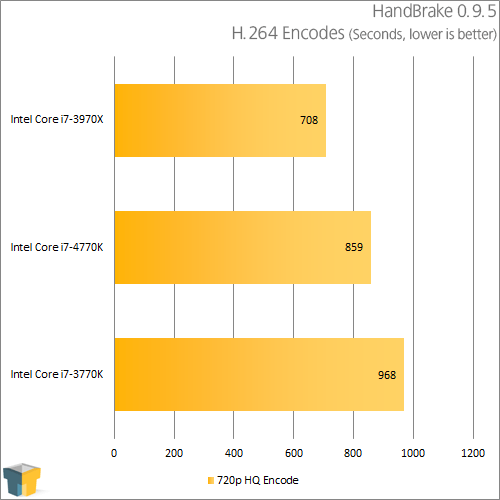
The results here almost perfectly scale with what we saw with our Adobe Premiere Pro test. The i7-4770K does eke a bit more performance in this test against the i7-3770K than the other, but it still averages out to about 11%.
CyberLink MediaExpresso
CyberLink is a company that’s quick to jump on new technologies, and it’s for that reason that CPU vendors – namely Intel – like to promote its products for use in benchmarking. In MediaExpresso’s case, this converter app can take advantage not only of basic CPU accelerators, but QuickSync and also AMD Radeon and NVIDIA GeForce.
We test a total of five configurations here:
- CPU Only – Faster Conversion
- CPU Only – Better Quality
- Intel QuickSync – Faster Conversion
- Intel QuickSync – Better Quality
- NVIDIA GeForce GTX 660 Ti
Because it’s a little hard to follow in a graph alone, we also include the same results in a table. This allows us to show you the fastest run overall, and then look at how each CPU fared in individual tests without having to squint through the results.
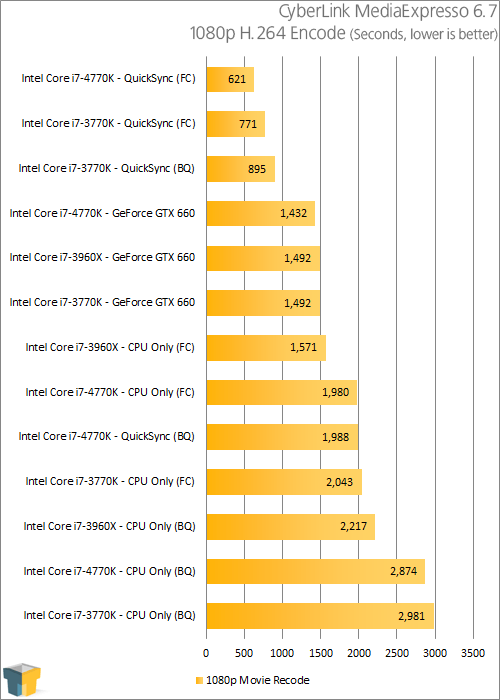
| CPU (BQ) | CPU (FC) | QS (BQ) | QS (FC) | GTX 660 | |
| Core i7-4770K | 2874 | 1980 | 1988 | 621 | 1432 |
| Core i7-3770K | 2981 | 2043 | 895 | 771 | 1434 |
| Core i7-3970X | 2217 | 1571 | N/A | N/A | 1492 |
| CPU = CPU only; QS = QuickSync; BQ = Better Quality; FC = Faster Conversion | |||||
Within these results lies one that’s just a bit too odd: QuickSync + Better Quality on the i7-4770K. For some reason, that configuration required more than 3x the amount of time to complete than the i7-3770K did. We’ve shot an email off to Intel to see if we can’t get to the bottom of this, because it’s the only test that behaved like this (the others remained consistent; we retested from the beginning to verify).
That aside, in both of the tests that used only the CPU, the six-core i7-3960X sits comfortably in front. As expected, and outside of that bizarre QuickSync run, Intel’s i7-4770K gives us the overall performance boosts we’d expect. Interestingly, virtually no difference is seen between the 3rd and 4th gen Core processors when running the GeForce test, although it did prove slower on the 2nd gen i7-3960X.
Support our efforts! With ad revenue at an all-time low for written websites, we're relying more than ever on reader support to help us continue putting so much effort into this type of content. You can support us by becoming a Patron, or by using our Amazon shopping affiliate links listed through our articles. Thanks for your support!




